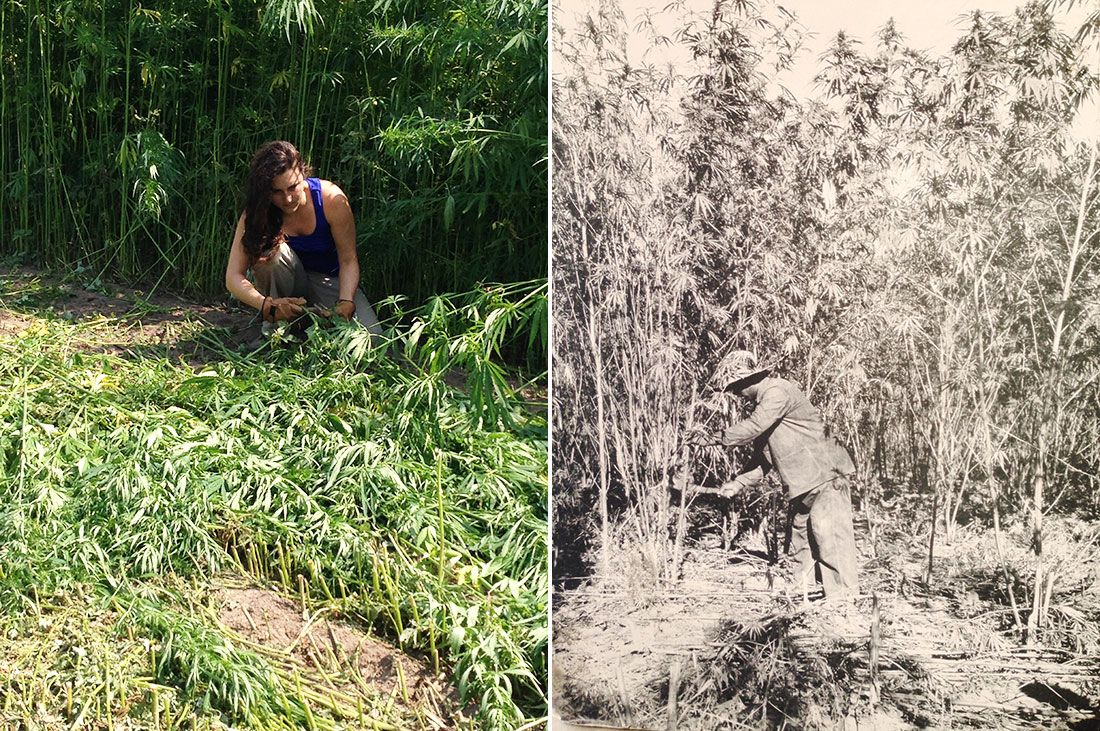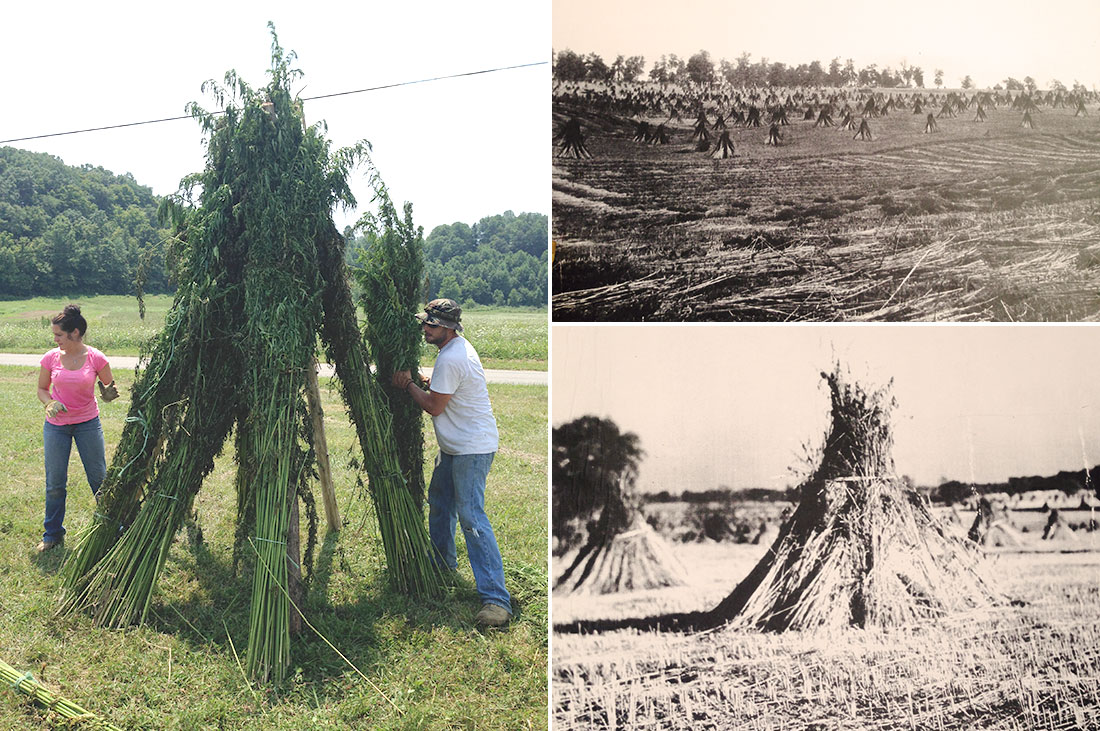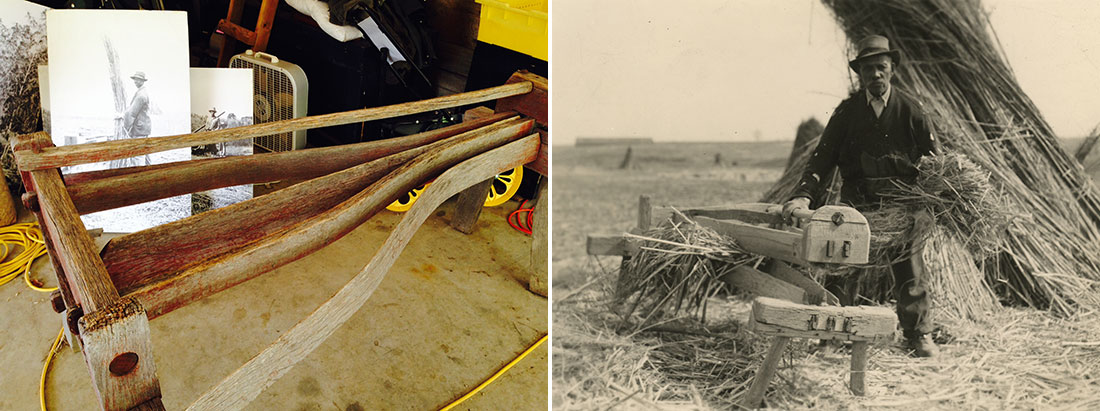Text and photos by Erin Axelrod. Historical photos courtesy of Kentucky Hemp Museum.
An earlier blog post by Ongeleigh Gipson, Kentucky Veterans Cultivate a Hemp Resurgence, discussed the promises of hemp cultivation to employ US veterans, grow a generation of new farmers, and revitalize a cellulose-based alternative to our current resource-intensive fiber industries. During the two days I spent at the Growing Warriors’ Farm (just an hour outside of Lexington, Kentucky), I had the honor of “re-discovering,” alongside Kevin Lanzi and Tali Smith, nearly-forgotten know-how of harvesting and processing this crop.
According to Michael Lewis, Executive Director of Growing Warriors, the nonprofit sponsor of the hemp pilot project in Kentucky, “We intend to work as hard as we can to bring the hemp crop from field to fiber as simply as we can. We are farmers and we are harvesting this crop as low-tech as possible to avoid purchasing large expensive equipment and going into debt. Hard work, grit, and determination is what built this country.”
This is the team’s vision. Below is the step-by-step roadmap for how they are harvesting hemp:
1) Reaping – Before the hemp flower goes to seed is the ideal time to harvest, as that is when the fiber is finest. Kevin used a John Deere tractor (pictured below, left) to cut down the stalks but the near-term vision they are working on is a partnership with a local Amish farmer who will use a horse-drawn reaper-binder for harvesting the hemp.
The hemp had been broadcast-seeded May 31st, 2014 and now, 63-days later, with zero-irrigation and zero-inputs, was towering over us (sometimes 11-foot tall!) and ready for harvesting. The team has discovered that seeding more densely keeps the weeds at bay, while also keeping the hemp stalks smaller, favoring crop quality over quantity.

2) Sorting/Bundling the stalks – Here, I enjoy the last bit of shade from the towering stalks of hemp as I sort the stalks into fine, medium-sized, and thick, which we tied into bundles with sisal. Tali says, “We are going to do the eastern side in the morning and the western side in the afternoon so we are always in the shade.” The Growing Warriors project hopes to discover, alongside veterans, strategies of production that allow them to farm smarter, not harder. Kevin and Tali are also quick to add that veterans, because of their background, have an ingrained work ethic that makes them incredible farmers, and a joy to work with.

3) Drying the stalks – The barn was filled with black and white photos donated to the project by the Kentucky Hemp Museum, depicting fields full of hemp “Teepees,” which Tali, Kevin, and I mimicked by building structures out of sugar maple poles collected in the woods nearby, and stacking the hemp bundles. Trying to separate off the leaves from the stalk without drying the stalk, results in unnecessary breaks and tears, compromising the integrity of the fiber. This drying process is also a precursor to the retting process, which is essential for efficient separation of the outer fibrous layer from the hurds (inner woody parts).

4) Separating the hemp bast fiber from the woody core – Once the hemp leaves have been removed, the remaining stalks must undergo a process of “retting,” (a glamorous way of saying “rotting”) to separate the outer layer of the stalk (the hemp bast fiber) from the inner wood core (the hurds).
Currently, the Kentucky Hemp Project is experimenting with three different methods of soaking the fibers to allow for a short period of fermentation, before drying them out again. Once this “retting” process is complete, the stalks will be prepped for separating the two types of fibers, used for distinct purposes — the outer stalk being the mainstay of fiber and cordage, while the inner hurds are more suitable for animal bedding and pulp.
Ultimately, Kevin envisions constructing a retting pond system on one hillside of the property so that all the retting water will cycle through a series of ponds while creating habitat and beauty for the veterans and the general public.
5) Hemp-breaking – After the retting, a simple mechanical breaker is used to separate the inner and outer fibers, Kevin intends to build one modeled off an old rotary hand hemp break.

6) Research and development – Patagonia company’s environmental grants program has paid for in-field processing equipment. With the assistance of Patagonia, as well as other non-profit organizations and altruistic donors, Fibershed will be researching hemp textile creation.
7) Sharing best practices – We’ve lost the people that are committed to upkeeping the tradition and methods of how to process valuable natural fiber crops like hemp. Given that much knowledge has been forgotten as a result of the decades-long ban on hemp cultivation in America, Kevin is an advocate for full and open-source transparency of best practices.
We are grateful that there are organizations like Growing Warriors, with the determination to bring back this Intellectual Capital as an expression of American patriotism and our country’s heritage.
